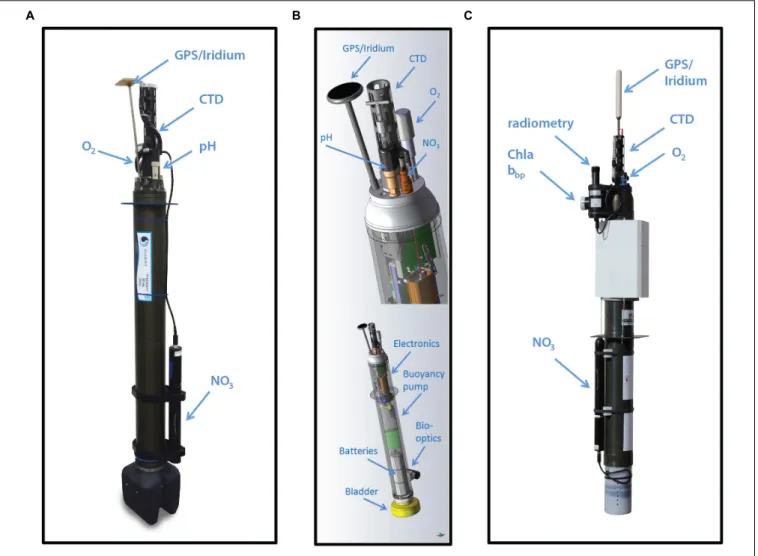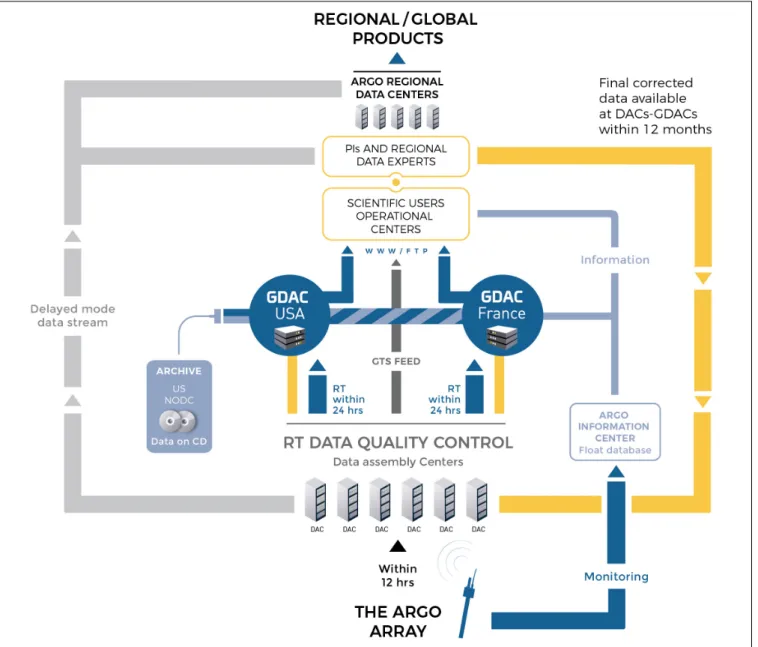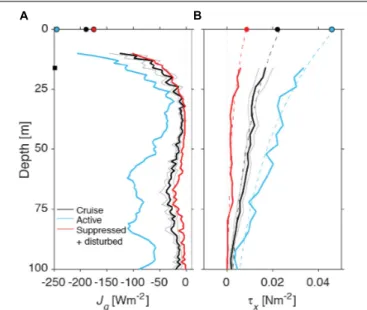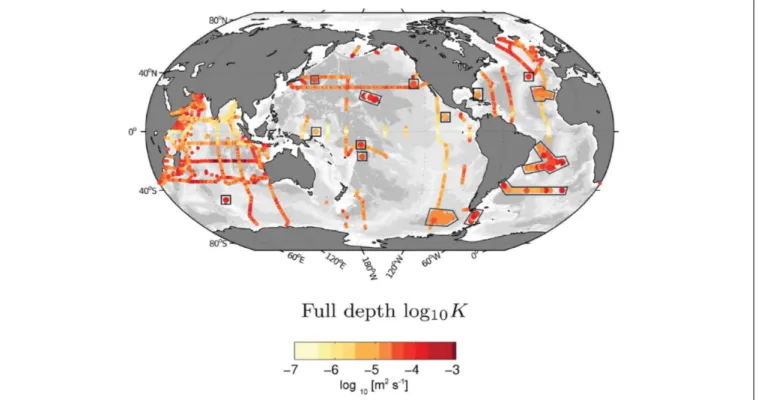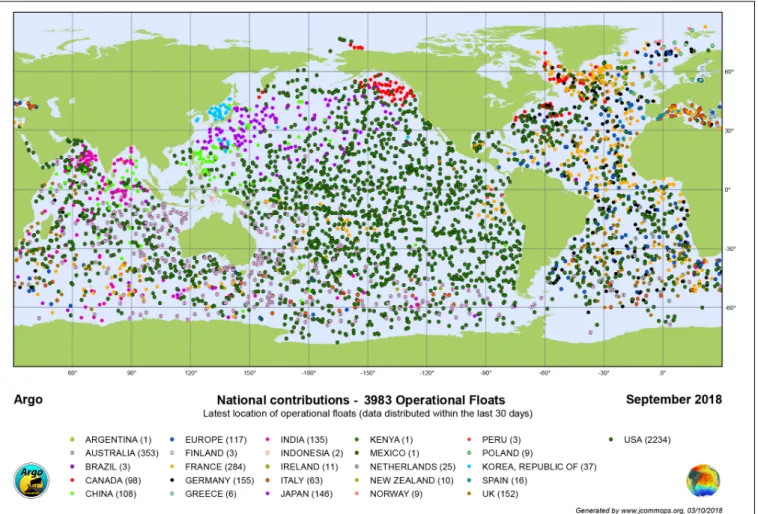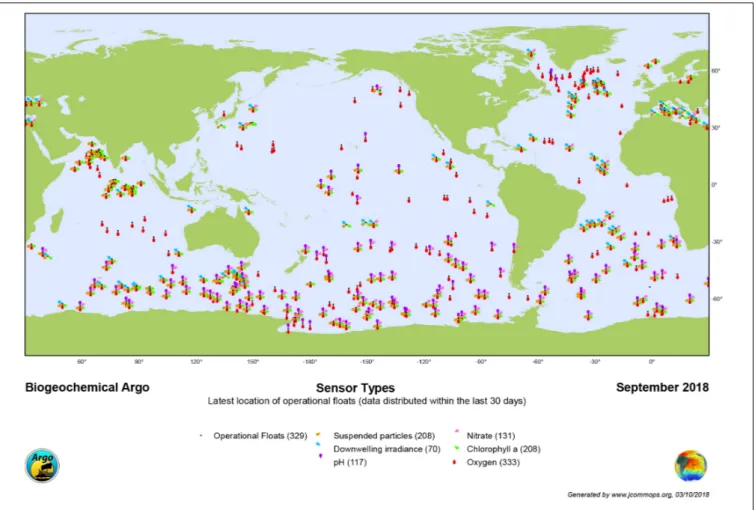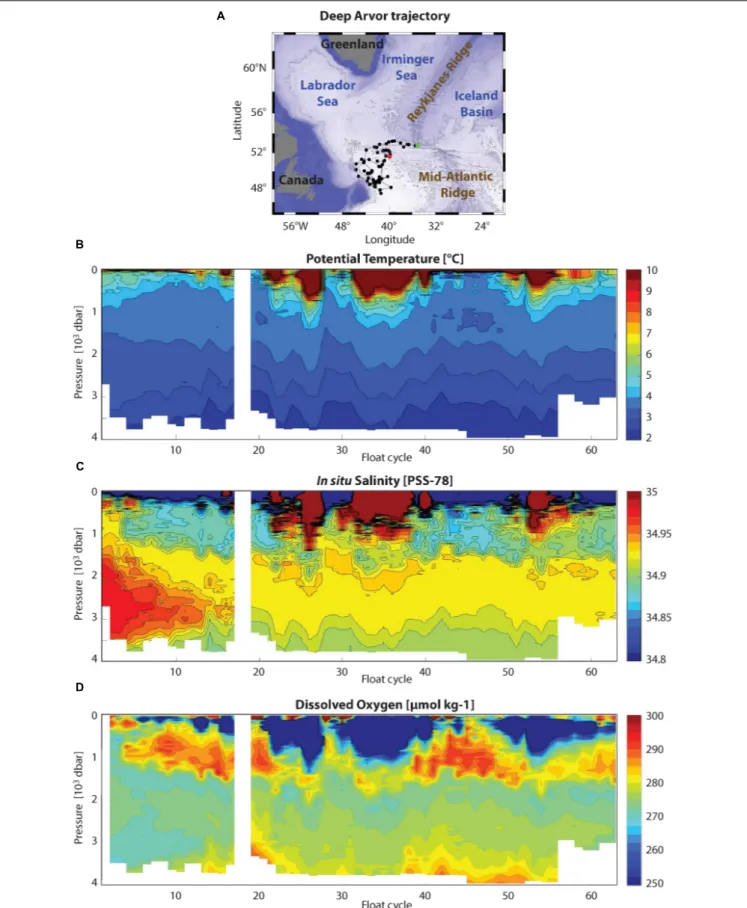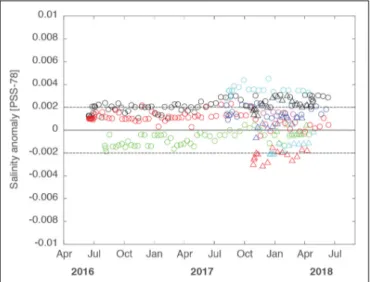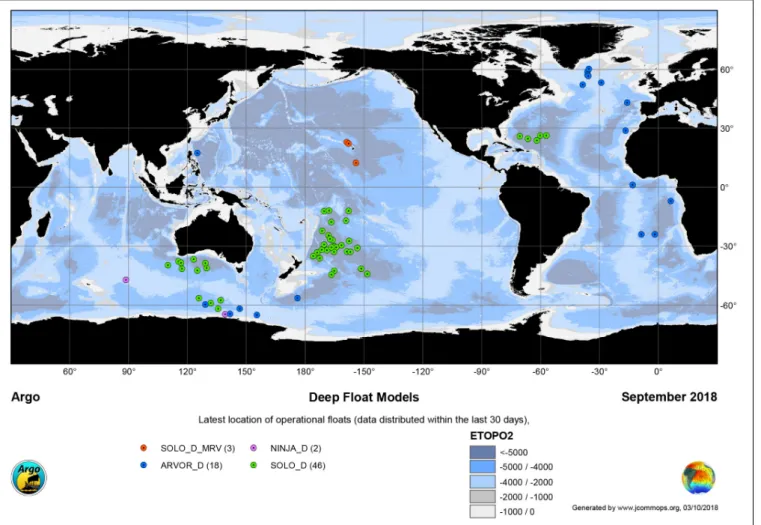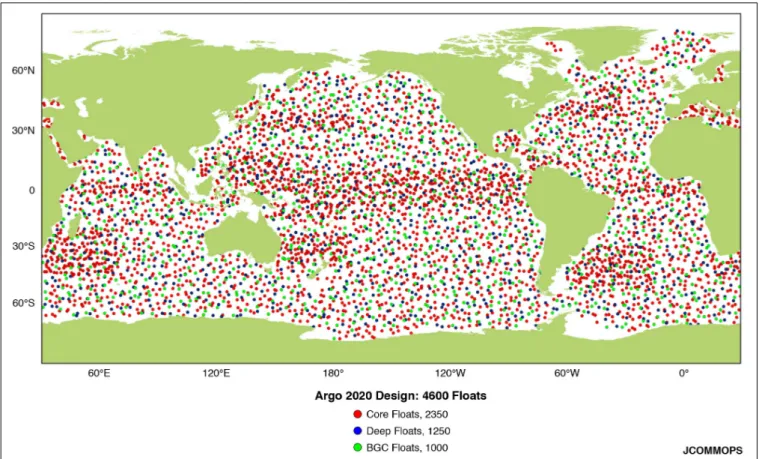doi: 10.3389/fmars.2019.00439
Edited by:
Amos Tiereyangn Kabo-Bah, University of Energy and Natural Resources, Ghana
Reviewed by:
Maxime M. Grand, Moss Landing Marine Laboratories, United States Paul James Durack, Lawrence Livermore National Laboratory (DOE), United States
*Correspondence:
Dean Roemmich droemmich@ucsd.edu
†Lead authors
Specialty section:
This article was submitted to Ocean Observation, a section of the journal Frontiers in Marine Science
Received:15 November 2018 Accepted:05 July 2019 Published:02 August 2019
On the Future of Argo: A Global,
Full-Depth, Multi-Disciplinary Array
Dean Roemmich1*†, Matthew H. Alford1†, Hervé Claustre2†, Kenneth Johnson3†, Brian King4†, James Moum5†, Peter Oke6†, W. Brechner Owens7†, Sylvie Pouliquen8†, Sarah Purkey1†, Megan Scanderbeg1†, Toshio Suga9†, Susan Wijffels7†,
Nathalie Zilberman1†, Dorothee Bakker10, Molly Baringer11, Mathieu Belbeoch12, Henry C. Bittig2, Emmanuel Boss13, Paulo Calil14, Fiona Carse15, Thierry Carval8, Fei Chai16, Diarmuid Ó. Conchubhair17, Fabrizio d’Ortenzio2, Giorgio Dall’Olmo18, Damien Desbruyeres8, Katja Fennel19, Ilker Fer20, Raffaele Ferrari21, Gael Forget21, Howard Freeland22, Tetsuichi Fujiki23, Marion Gehlen24, Blair Greenan25,
Robert Hallberg26, Toshiyuki Hibiya27, Shigeki Hosoda23, Steven Jayne7,
Markus Jochum28, Gregory C. Johnson29, KiRyong Kang30, Nicolas Kolodziejczyk31, Arne Körtzinger32, Pierre-Yves Le Traon33, Yueng-Djern Lenn34, Guillaume Maze8, Kjell Arne Mork35, Tamaryn Morris36, Takeyoshi Nagai37, Jonathan Nash5,
Alberto Naveira Garabato4, Are Olsen20, Rama Rao Pattabhi38, Satya Prakash38, Stephen Riser39, Catherine Schmechtig40, Claudia Schmid11, Emily Shroyer5, Andreas Sterl41, Philip Sutton42, Lynne Talley1, Toste Tanhua32, Virginie Thierry8, Sandy Thomalla43, John Toole7, Ariel Troisi44, Thomas W. Trull6, Jon Turton15,
Pedro Joaquin Velez-Belchi45, Waldemar Walczowski46, Haili Wang47, Rik Wanninkhof11, Amy F. Waterhouse1, Stephanie Waterman48, Andrew Watson49, Cara Wilson50,
Annie P. S. Wong39, Jianping Xu16and Ichiro Yasuda51
1Scripps Institution of Oceanography, La Jolla, CA, United States,2French National Center for Scientific Research, Villefranche Oceanographic Laboratory, Sorbonne Université, Villefranche-sur-Mer, France,3Monterey Bay Aquarium Research Institute, Moss Landing, CA, United States,4National Oceanography Centre, Southampton, United Kingdom,
5College of Earth, Ocean, and Atmospheric Sciences, Oregon State University, Corvallis, OR, United States,
6Commonwealth Scientific and Industrial Research Organisation, Hobart, TAS, Australia,7Woods Hole Oceanographic Institution, Woods Hole, MA, United States,8Institut Français de Recherche pour l’Exploitation de la Mer, Brest, France,
9Department of Geophysics, Graduate School of Science, Tohoku University, Sendai, Japan,10School of Environmental Sciences, Centre for Ocean and Atmospheric Sciences, University of East Anglia, Norwich, United Kingdom,11Atlantic Oceanographic and Meteorological Laboratory, National Oceanic and Atmospheric Administration, Miami, FL, United States,
12JCOMMOPS, Brest, France,13School of Marine Sciences, The University of Maine, Orono, ME, United States,14Institute of Coastal Research, Helmholtz-Zentrum Geesthacht, Geesthacht, Germany,15UK Met Office, Exeter, United Kingdom,
16State Key Laboratory of Satellite Ocean Environment Dynamics, Second Institute of Oceanography, Ministry of Natural Resources, Hangzhou, China,17Irish Marine Institute, Galway, Ireland,18Plymouth Marine Laboratory, Plymouth, United Kingdom,19Department of Oceanography, Dalhousie University, Halifax, NS, Canada,20Physical Oceanography, Geophysical Institute, University of Bergen, Bergen, Norway,21Massachusetts Institute of Technology, Cambridge, MA, United States,22Fisheries and Oceans Canada, Sidney, BC, Canada,23Japan Agency for Marine-Earth Science and Technology, Yokosuka, Japan,24Laboratoire des Sciences du Climat et de l’Environnement/Institut Pierre Simon Laplace, Gif-sur-Yvette, France,25Bedford Institute of Oceanography and Fisheries and Oceans Canada, Dartmouth, NS, Canada,26National Oceanic and Atmospheric Administration, Geophysical Fluid Dynamics Laboratory, Princeton, NJ, United States,27Graduate School of Science, Department of Earth and Planetary Science, The University of Tokyo, Tokyo, Japan,28Neils Bohr Institute, Copenhagen, Denmark,29National Oceanic and Atmospheric Administration/Pacific Marine Environmental Laboratory, Seattle, WA, United States,30Korea Meteorological Administration, Seoul, South Korea,
31CNRS-IRD-Ifremer, LOPS Laboratory, University of Brest, Brest, France,32Helmholtz-Zentrum für Ozeanforschung Kiel, Kiel, Germany,33Mercator-Ocean, Brest, France,34School of Ocean Sciences, Bangor University, Bangor, United Kingdom,
35Institute of Marine Research, Bergen, Norway,36Marine Research Unit, South African Weather Service, Cape Town, South Africa,37Graduate School of Marine Science and Technology, Ocean Sciences, Tokyo University of Marine Science and Technology, Tokyo, Japan,38Indian National Centre for Ocean Information Services, Hyderabad, India,39School of Oceanography, College of the Environment, University of Washington, Seattle, WA, United States,40French National Center for Scientific Research, OSU Ecce Terra, Sorbonne Université, Paris, France,41Koninklijk Nederlands Meteorologisch Instituut, De Bilt, Netherlands,42National Institute of Water and Atmospheric Research, Auckland, New Zealand,43Southern Ocean Carbon & Climate Observatory, Cape Town, South Africa,44Servício de Hídrografia Naval, Buenos Aires, Argentina,
45Instituto Espanol de Oceanografia, Canary Islands, Spain,46Institute of Oceanology Polish Academy of Sciences, Sopot, Poland,47State Key Laboratory of Marine Environmental Science, Xiamen University, Xiamen, China,48Department of Earth,
Ocean and Atmospheric Sciences, The University of British Columbia, Vancouver, BC, Canada,49Earth System Science Group, College of Life and Environmental Science, University of Exeter, Exeter, United Kingdom,50National Oceanic and Atmospheric Administration – National Marine Fisheries Service, Pacific Grove, CA, United States,51Atmosphere and Ocean Research Institute, The University of Tokyo, Tokyo, Japan
The Argo Program has been implemented and sustained for almost two decades, as a global array of about 4000 profiling floats. Argo provides continuous observations of ocean temperature and salinity versus pressure, from the sea surface to 2000 dbar. The successful installation of the Argo array and its innovative data management system arose opportunistically from the combination of great scientific need and technological innovation. Through the data system, Argo provides fundamental physical observations with broad societally-valuable applications, built on the cost-efficient and robust technologies of autonomous profiling floats. Following recent advances in platform and sensor technologies, even greater opportunity exists now than 20 years ago to (i) improve Argo’s global coverage and value beyond the original design, (ii) extend Argo to span the full ocean depth, (iii) add biogeochemical sensors for improved understanding of oceanic cycles of carbon, nutrients, and ecosystems, and (iv) consider experimental sensors that might be included in the future, for example to document the spatial and temporal patterns of ocean mixing. For Core Argo and each of these enhancements, the past, present, and future progression along a path from experimental deployments to regional pilot arrays to global implementation is described. The objective is to create a fully global, top-to-bottom, dynamically complete, and multidisciplinary Argo Program that will integrate seamlessly with satellite and with otherin situ elements of the Global Ocean Observing System (Legler et al., 2015). The integrated system will deliver operational reanalysis and forecasting capability, and assessment of the state and variability of the climate system with respect to physical, biogeochemical, and ecosystems parameters. It will enable basic research of unprecedented breadth and magnitude, and a wealth of ocean-education and outreach opportunities.
Keywords: Argo, floats, global, ocean, warming, circulation, temperature, salinity
INTRODUCTION
The Argo Program is a major component of both the Global Ocean Observing System (GOOS) and the Global Climate Observing System (GCOS), providing near-real time data for ocean and atmospheric services and high quality data for climate research. The Argo Program began its implementation in 1999 and has provided global coverage of the upper 2000 m of the oceans since 2006. By November 2018, Argo had provided 2,000,000 profiles since the program began, and a comparable number of velocity drift estimates at 1000 m depth. Although originally designed to provide temperature and salinity profiles in the upper 2 km of the ice-free oceans, the array has been expanded into seasonal ice zones using floats equipped with ice avoidance algorithms. Argo profiling floats also are sampling in many marginal seas. In addition, ongoing regional pilot programs have demonstrated that Argo floats can now (1) measure biogeochemical parameters to address oceanic uptake of carbon, acidification and deoxygenation (Biogeochemical, BGC, Argo) and (2) make measurements throughout the water column to 6000 m depth (Deep Argo). Notification through the
Argo Information Center (AIC), following Intergovernmental Oceanographic Commission (IOC) guidelines to protect the rights of Coastal States, has enabled global coverage. Presently the number of functioning Argo floats remains steady, with total float count around 4000. This has been possible, despite relatively flat funding, through a collaboration of international partners and significant technological innovation. The Argo Data System provides real-time data within 24 h of collection through the Global Telecommunications System (GTS) and via the internet for use at global prediction centers. The Argo Data Management Team (ADMT) also oversees delayed-mode quality control of the data and the availability of Argo data at the Argo Global Data Assembly Centers.
To meet future needs, Argo should (1) support continuing innovation in float technology, (2) enhance coverage in critical regions such as the equatorial band, where higher temporal resolution is needed and the western boundary regions where mesoscale ‘noise’ is high, (3) implement Deep Argo and Biogeochemical Argo in the global array, (4) assess the technical readiness and scientific value of experimental measurements for possible future inclusion in Argo, for example those used to
estimate small scale mixing, and (5) collaborate with our end- user community to improve the use of Argo data in prediction systems and services. This review lays out the motivation, development, and present status of the Argo Program, and addresses the five issues mentioned above. It is important to note that Core Argo has reached and maintained full implementation through innovation and broad community support. Only a small fraction of the funding needed to support the ambitious community requests for an expanded Argo Program can be identified at present. It is important for Argo to meet its future challenges as a single integrated program. The present elements of Argo – Core, Deep, and BGC – and of its data management system are not separable, and any other future enhancements will similarly be considered as contributions to the unified effort.
MOTIVATION, DEVELOPMENT, TECHNOLOGY
Core Argo
During the 1990s, the World Ocean Circulation Experiment brought increased understanding of important oceanic roles in climate variability and change (Siedler et al., 2001). The need to observe the global subsurface ocean, together with a fit-for-purpose revolutionary autonomous technology (Davis et al., 2001), led to a multinational proposal for a global subsurface ocean observing system (Argo Steering Team, 1998).
The proposed ‘Argo Program’ would be comprised of over 3000 profiling floats, obtaining a snapshot of the physical state of the ocean from 0 to 2000 m every 10 days. All data would be freely shared in near-real time (NRT, within 24 h) to support forecasting, and with a highly quality-controlled delayed-mode (DM) version delivered within 12 months for climate research and assessments. Argo floats were deployed in regional arrays beginning in 1999 and then globally from 2004 to the present.
Argo has fulfilled its promise to complement and integrate across many satellite and in situ elements of the GOOS and across many regional observational networks (deYoung et al., 2019; Foltz et al., 2019; Hermes et al., 2019; Lee et al., 2019;
Newman et al., 2019; Palazov et al., 2019; Smith et al., 2019;
Todd et al., 2019).
A number of key elements that contributed to Argo’s success over the past 20 years are evident. The underpinning profiling float technology is simple, robust, and cost-effective.
A strong international consensus on the high value of Argo, by agencies and the science community, contributed to Argo’s rapid roll-out. Once Argo was in place, a broad base of applications (see section “Core Argo” under the section “End User Engagement”) including basic research, assessment of the state of the Earth’s climate, tertiary and secondary education, and ocean modeling for reanalysis and operational prediction, drew strong community support. Effective partnerships developed between Argo teams and commercial suppliers, to exploit and improve float and sensor technologies. The IOC provided necessary protocols to facilitate the operation of Argo floats in national waters (Intergovernmental Oceanographic Commission
[IOC], 1999), while the AIC1 supplied the mechanisms for tracking and reporting to coastal states (Pinardi et al., 2019).
Technology advances have continued throughout Argo’s 20- year history. New generation profiling floats are smaller, lighter, and more energy efficient. A profoundly important transition from unidirectional to faster bidirectional communication (Iridium) improves vertical resolution and shortens surface times from 12 h to 20 min, greatly reducing bio-fouling, array divergence due to surface drift, grounding, and other hazards.
Ice-avoidance measures in float controllers (Klatt et al., 2007) have extended the range of Argo through the seasonal ice zones (Wong and Riser, 2011). Improved CTD sensors, as well as procedures for delayed-mode quality control (Owens and Wong, 2009) have increased the accuracy and consistency of the Argo dataset. Float lifetimes have increased, to 4–5 years for most Argo National Programs, reducing the cost per profile while extending reseeding intervals. All of these improvements are propagated across the Argo national programs through communication of Best Practices (Pearlman et al., 2019).
Argo’s systematic and regular observation of the global subsurface ocean has transformed ocean observing. Northern hemisphere, near-coastal, and seasonal sampling biases of earlier eras are removed. The global Argo array has been sustained and improved for more than a decade, providing data for over 3000 research publications and becoming a mainstay of global ocean data assimilation, modeling, and prediction applications. The notable convergence, in the Argo era, of diverse estimates of historical global ocean heat content changes (e.g., Johnson et al., 2016) has increased the confidence that can be placed on the reliability of national and international assessments of climate change. International partners in Argo merge their efforts to produce a seamless global array, providing standardized observations, and delivering near real- time and research quality data with public access. Argo has led the way among ocean observing networks with regard to international cooperation, operations planning, Data Availability, and metadata quality.
BGC-Argo
The Biogeochemical (BGC)-Argo program began with the deployment of optical (Bishop et al., 2002;Mitchell, 2003;Boss et al., 2008) and oxygen (Körtzinger et al., 2004; Riser and Johnson, 2008) sensors on profiling floats between 2000 and 2003.
The success of these efforts was highlighted at the Autonomous Platforms and Sensors meeting (Rudnick and Perry, 2003), which was the founding meeting for this community. It was followed by the development of a global vision for biogeochemical data acquisition through the inclusion of oxygen sensors on Argo platforms (Gruber et al., 2007), and the launch the same year of a working group of the International Ocean- Color Coordinating Group, “Bio-optical sensors on Argo floats”
(IOCCG, 2011). In the meantime, both the oxygen and optical communities were promoting their vision for developing a global network of profiling floats carrying oxygen and optical sensors as part of the OceanObs09 conference (Claustre et al., 2010;
1http://argo.jcommops.org/
Gruber et al., 2010), following a meeting inJohnson et al. (2009) that addressed the development of a global observing system using both gliders and profiling floats.
In 2016, a meeting was held in Villefranche-sur-mer to develop an implementation plan for BGC-Argo. The subsequent report (Biogeochemical-Argo Planning Group, 2016) was the starting point of the BGC-Argo program. Observing system simulation experiments (OSSEs) performed for this meeting suggested that a 1000-float array would significantly constrain the processes that control global oxygen and carbon distributions, including air-sea fluxes and exports from the surface (Kamenkovich et al., 2017). Assuming a mean BGC float lifetime of 4 years, sustaining a 1000-float array requires 250 floats per year with an estimated annual cost near US$25-M. Each of the floats would carry sensors for six core ocean variables measured with targeted accuracies2: chlorophyll fluorescence (Chla), particle backscatter, oxygen, nitrate, pH, and irradiance. The 1000-float array would provide observational data to transform ability to quantify: (i) air-sea carbon fluxes, (ii) ocean deoxygenation, oxygen minimum zones and related denitrification fluxes, (iii) ocean acidification, (iv) the biological carbon pump, and (v) phytoplankton communities. The observing system would improve management of living marine resources and carbon budget verification, both key societal goals. In 2017, a BGC- Argo Scientific Steering Committee was formed (under the Argo Steering Team), to guide the development of the network and the implementation of the program objectives, and to continue developing a vision for the future. In 2018, during the Executive Council of IOC, unanimous support from Member States was given to the proposal to incorporate the six biogeochemical measurements in the Argo array. Additionally the Executive Council approved a framework for the future addition of new parameters to Argo.
The first BGC-Argo deployments consisted of a few floats at a time. These have evolved to regional scale projects such as remOcean (North Atlantic sub-polar Gyre, 20 floats) and NAOS (Mediterranean Sea, 30 floats), and to basin-scale projects such as SOCCOM (Southern Ocean Carbon and Climate Observations and Modeling) with more than 100 floats deployed thus far, toward a target of 200. These pilots have showcased the potential of community-shared efforts to support better understanding of major biogeochemical processes at the global scale and to explore new research topics. The profiling float data sets have been vetted by research groups via publications approaching several 100 in total. BGC-Argo observations are open and free through the Argo data system both in NRT and DM.
These projects are transforming our understanding of variability in the ocean over time scales difficult to achieve with ship-based observations. A few of these achievements include characterization of ocean nitrate supply (Johnson et al., 2010; D’Ortenzio et al., 2014); observation of bloom dynamics beneath the surface (Boss and Behrenfeld, 2010;
Mignot et al., 2018); novel carbon export mechanisms through a mixed-layer pump (Dall’Olmo and Mork, 2014; Dall’Olmo et al., 2016) or eddy subduction (Llort et al., 2018); oxygen
2http://biogeochemical-argo.org/measured-variables-general-context.php
minimum zone processes (Whitmire et al., 2009;Prakash et al., 2012; Stanev et al., 2018); ocean net community production over complete annual cycles throughout the ocean (Riser and Johnson, 2008; Bushinsky and Emerson, 2015; Hennon et al., 2016; Plant et al., 2016); ocean ventilation (Körtzinger et al., 2004; Wolf et al., 2018); air-sea exchanges of O2 (Bushinsky et al., 2017) and CO2 (Williams et al., 2017; Bittig et al., 2018;
Gray et al., 2018); and mesoscale/sub-mesoscale processes (Sukigara et al., 2011;Kouketsu et al., 2016). In a major advance, the data are now being assimilated into biogeochemical models to enable greater understanding and improved predictions (Verdy and Mazloff, 2017).
The development of BGC-Argo floats has been based on the standard Argo Pressure/Temperature/Salinity (P/T/S) platforms, integrating new sensors when their readiness level appeared compatible with long-term, operational use. Today, the community is operating three main BGC-Argo platforms (Figure 1): PROVOR, Navis, and APEX floats. While each of these platforms is capable of carrying the six core sensors outlined in the BGC-Argo implementation plan, due to present hardware limitations and the objectives of funded research programs, few have yet been deployed with all six. Deployments of floats carrying the six core variables are highly desirable as well as harmonizing of mission parameters with those of Core Argo.
Deep Argo
Deep Argo is motivated by the substantial oceanographic variability found in the 50% of ocean volume that lies below the 2000-dbar profiling target for conventional Argo floats. Development of floats and CTDs capable of accurate measurements to 6000 dbar makes global full- depth Argo implementation feasible, including sampling of bottom-intensified ocean variability.
Antarctic Bottom Water, which fills much of the ocean below 2000 dbar (Johnson, 2008), has been warming and freshening during the past few decades, with these changes contributing to steric sea level rise (Purkey and Johnson, 2013). The rate of ocean heat-gain below 2000 dbar, of 0.065 (± 0.04) W m−2 from 1991 to 2010 (Desbruyères et al., 2016) is about 10% of the 0.61 ( ± 0.09) W m−2 from 2005 to 2015 in the upper 1800 dbar (Johnson et al., 2016). Deep ocean (>2000 dbar) heat content changes have been estimated over decadal intervals using a sparse network of repeat hydrographic sections that are sampled at quasi-decadal intervals (Talley et al., 2016), hence only decadal estimates are possible, and uncertainties due to the sparsity of observations are about 2/3 the size of the signal. In contrast, Core Argo data enables decadal estimation of ocean heat uptake shallower than 2000 dbar with uncertainties only about 1/7 the size of the signal. In addition, monthly global analyses of Core Argo data (Roemmich and Gilson, 20093) have provided a basis for investigation of seasonal-to-interannual variability (e.g.,Johnson and Birnbaum, 2017). Deep Argo will similarly reduce the uncertainties in decadal deep ocean heat uptake estimates, while providing data for a broad range of scientific investigations of deep variability (Johnson et al., 2015).
3http://sio-argo.ucsd.edu/RG_Climatology.html
FIGURE 1 |The three main models of BGC-Argo floats presently in use include(A)Navis,(B)APEX, and(C)PROVOR.
The fact that abyssal trends and diffusivities both seem to be insufficiently constrained in ocean state estimates is further evidence that deep Argo is needed (Wunsch and Heimbach, 2014;
Forget et al., 2015).
North Atlantic Deep Water is also changing, with the meridional overturning circulation decreasing measurably between 2004–2008 and 2008–2012 (Smeed et al., 2018). Deep ocean circulation variations have primarily been observed using transoceanic moored arrays, which are costly to maintain, and hence regionally limited (Lozier et al., 2017;Meinen et al., 2017;
Smeed et al., 2018). Repeat hydrographic section data are also used for this purpose despite their sparse temporal sampling (Bryden et al., 2005; Kouketsu et al., 2011). Deep Argo would provide velocity and density information, complementing both the moored arrays and repeat hydrography, as well as facilitating decadal climate predictions and constraining full-depth ocean data assimilation (Robson et al., 2012; Yeager et al., 2012;
Carrassi et al., 2016).
The value and technical feasibility of a Deep Argo Program were recognized at OceanObs’09 (Roemmich et al., 2010).
Successful deployments of prototype deep floats and CTDs in
2012–2014 led to a Deep Argo Implementation Workshop in May 2015 (Zilberman and Maze, 2015), where a plan for Deep Argo’s progression to a global 5◦×5◦array was endorsed. Regional pilot arrays have been established in the South Pacific, South Indian, and North Atlantic oceans, further demonstrating the feasibility of a global Deep Argo array.
Argo Data Management
The Argo data system was designed in 2001 at the 1stArgo Data Management meeting in Brest, France and its main components remain in place and function well (Figure 2). The national Data Assembly Centres (DACs) receive data via satellite transmission, decode it, and apply quality control according to a set of agreed NRT tests. Erroneous data are corrected if possible, flagged accordingly and then sent to two Global Data Assembly Centres (GDACs) and the GTS. The GDACs collect the data from the 11 DACs, synchronize their databases daily and serve the data on FTP sites. The AIC monitors the status of the Argo Program, including data distribution, and meta data that incorporate float location, model, transmission system, owner, etc. In addition, the AIC gathers feedback on data quality from
FIGURE 2 |Pathways of Argo near-real time and delayed-mode data and meta data are illustrated, originating from the Argo array and being distributed to users via the GDACs. (Copyright: Euro-Argo ERIC, printed with permission).
users and relays it to float owners and DACs. Argo’s delayed- mode data system for P/T/S variables relies on Argo data experts examining the data and reflagging where necessary, using a standard method (Owens and Wong, 2009) to estimate salinity drift, in addition to applying salinity thermal lag adjustments and pressure adjustments.
To improve the quality of P/T/S variables between NRT and DM versions, a few tests have been developed to run on a regular basis (e.g., monthly, quarterly, etc.) on the GDAC data holdings.
One of these is an objective analysis run monthly by Coriolis, where profiles that are inconsistent with neighbors are identified for further examination. Another is a quarterly comparison with satellite altimetry performed by CLS/France. When suspect profiles are identified, float owners and DACs are notified to make changes to data QC flags as needed.
The Argo Regional Centers (ARCs) perform a variety of tasks including coordinating float deployments, consistency checks on delayed mode quality control, finding additional reference data for delayed mode work, adopting floats for delayed mode quality control, and producing Argo data products.
While the complete data management chain (Figure 2) has been developed for the core mission (P/T/S, 0–2000 dbar), the extensions to Deep Argo and BGC Argo are under development to form an integrated Argo Data Management System.
ArgoMix
Here a new enhancement is suggested for possible future inclusion in Argo, consisting of direct shear and scalar microstructure (turbulence) measurements for both the upper and deep ocean. The rationale is provided by recent scientific
and technical developments. Microstructure measurements are not presently part of Argo but are presented as an example of how new experimental measurements on profiling floats can progress toward inclusion in the global array. This process, begins with limited deployment outside of Argo to demonstrate value and capabilities.
Turbulent mixing in the ocean is important because (1) it contributes to the transport and distributions of heat, freshwater, dissolved gasses, and pollutants, (2) it impacts biological processes by determining the flow field for the smallest plankton and setting large-scale gradients of nutrient availability, and (3) societally-valuable predictions from numerical models of quantities such as temperature and sea level depend sensitively on the geography of ocean mixing rates. Despite its importance, observations of ocean turbulence are extremely sparse, particularly in the deep ocean. Imprints of turbulent transport processes on the large scale ocean state, as readily observed by Core Argo, allow for inversion of diffusivity maps but direct mixing measurements are needed to further constrain inverse estimates (Forget et al., 2015).
Ocean turbulence is of leading order importance in determining the variability of many of the 11 physics-based GCOS “essential ocean variables” (EOVs). For example, turbulence determines the divergence of surface buoyancy fluxes across the surface mixed layer. On larger scales the flux of constituents (e.g., heat or salt) enhanced by turbulence are critical to understanding weather and climate. At present, physics-based EOVs include the surface and subsurface values of ocean currents (u,v), temperature (T) and salinity (S). At any subsurface location, these three EOVs vary in accordance to the Navier-Stokes equations, but thermodynamically they vary solely with the vertical (or diapycnal) divergences of turbulence-enhanced fluxes of momentum, heat, and salt. The physics-based EOVs also include the fluxes of momentum (wind stress) and heat at the sea surface. These fluxes provide surface inputs but do not quantify internal redistributions and so cannot define changes inuorT. However, fluxes of heat and momentum can now be reliably assessed using direct shear and scalar microstructure turbulence measurements (Pujiana et al., 2018) as witnessed by flux measurements that asymptote to and vary with independently-measured surface values (Figure 3).
Recent work suggests considerable temporal and spatial inhomogeneity in near-surface and deep-ocean mixing. Moored mixing time series in the upper few 100 m (Moum et al., 2009, 2013) have, for example, identified the importance of subsurface turbulence fluxes in setting the annual cycle of tropical sea surface temperature (SST), and shown variability on long time scales that include ENSO. Furthermore, mixing measurements in the deep ocean (Alford et al., 2011) show intense intermittency, indicating a need for sustained global measurements through the full water column.
The importance of small scale mixing to prediction of global scale circulation, including how this might be quantified, was a focus of the recent Climate Process Team on Ocean Mixing (MacKinnon et al., 2017). In particular, global distributions of mixing (Whalen et al., 2012, 2015; Waterhouse et al., 2014) based on indirect fine-scale parameterizations and internal wave
FIGURE 3 |Quantitative demonstration of turbulence fluxes assessed from turbulence profiling. Vertical profiles of the turbulent fluxes of heat(A)and momentum(B)derived from turbulence profiling measurements akin to those proposed for ArgoMix. In the legend, “active” refers to strong surface forcing;
“suppressed” to weak surface forcing. Surface values of the fluxes are indicated by the dots at depth = 0. Measurements are from the equatorial Indian Ocean before (red) and during (blue) the passage of westerly wind bursts of the MJO. Subsurface fluxes co-vary with the forcing and asymptote to surface values, as they must [Source: adapted fromPujiana et al., 2018, Copyright 2018 American Meteorological Society (AMS). Reprinted with permission].
models (Gregg, 1989;Olbers and Eden, 2013;Polzin et al., 2014;
Pollman et al., 2017) represent a new paradigm against which to test theory and models, and to target new process experiments.
However, the underlying assumptions of these methods are uncertain and may be most suspect where the inferred turbulence is greatest. While the fine-scale parameterizations tend to agree with direct measurements to within a factor of two in the ocean interior, a significantly higher standard is required to understand turbulent flux divergences that govern evolution of EOVs. The assumptions in these methods are known to be violated near boundaries, with differences between parameterizations and direct measurements of up to a factor of 10 (Waterman et al., 2014). In addition to the diapycnal fluxes, direct microstructure measurements can also allow assessment of isopycnal stirring and its underpinning dynamics (Ferrari and Polzin, 2005;
Naveira Garabato et al., 2015).
Direct measurements on both Argo and Deep Argo floats are now feasible, owing to recent advances in turbulence sensing technology that have reduced the cost, communications bandwidth, and power requirements. Recent technological advances in inexpensive and low-power circuitry, increased battery capacity and data storage density have led to an ability to make long-term continuous measurements of mixing from oceanographic moorings (Moum and Nash, 2009) and profiling instruments (Sherman and Davis, 1995;Nagai et al., 2015;Goto et al., 2016, 2018; Lucas et al., 2016; Shroyer et al., 2016).
These systems have been tested quantitatively via inter-platform comparisons (Perlin and Moum, 2012; Pujiana et al., 2018) and schemes to compress data for satellite transmission have been developed (Becherer and Moum, 2017). These are key technical ingredients for successful implementation of mixing measurements on the Argo fleet.
Roughly a dozen moored mixing measurements are now distributed around ocean basins, permitting important but highly limited geographic comparisons. While this effort has been an exciting development, these measurements cannot address problems associated with widespread geographical variations in mixing, deep thermocline and abyssal mixing, or variability away from the moorings. Existing monitoring efforts specifically do not address mixing variability at Argo resolution, as seen in sparse but highly variable deep microstructure observations (Figure 4;
Waterhouse et al., 2014).
THE PRESENT STATUS, PROBLEMS, AND STRENGTHS
Core Argo
The number of floats reporting Core Argo parameters increased rapidly from 1999 until it reached 3000 during 2007, and has increased slowly over the last 10 years to its present number of 4000 (Figure 5). Recent increases reflect floats deployed in previously unsampled regions and regions of higher than standard sampling density. More than 90% of measurements made on Argo floats are available within Argo’s 24 h target
(see section “Argo Data Management” under the section
“The Present Status, Problems, and Strengths”), and all are freely distributed.
Core Argo has a mature leadership model, with Steering and Data Management Teams that meet annually in plenary, and with vigorous inter-sessional activity. These meetings are supplemented with workshops on technical aspects as required, such as hardware engineering, sensor development, and data quality control. Argo leadership has a strong corporate memory, which ensures the stability of the program. Argo regularly audits the performance of the array so that systematic problems can be identified before they seriously degrade the data.
Argo data acquisition is distributed across 25 national programs (Figure 5). The procedures for delivery of data in NRT and DM (see section “Argo Data Management” under the section “The Present Status, Problems, and Strengths”) are comprehensively described in public documents. This ensures a global dataset of consistent quality and uniform format ready for public use. Reliability of data does not depend on the originating national program or investigator.
Since 2013, Argo has undertaken a major revision of its data format in order to incorporate data from biogeochemical sensors and other auxiliary measurements. This includes improving the quality of meta data to enable more detailed array audits. This additional complexity (see section “Argo Data Management” under the section “The Present Status, Problems, and Strengths”), while essential, has placed a burden on the data system and has diverted effort from DMQC of the core physical parameters.
FIGURE 4 |Depth-averaged diffusivity from the surface to the bottom from all existing full-depth microstructure observations as ofWaterhouse et al. (2014). [Source:
Waterhouse et al., 2014, Copyright 2014 American Meteorological Society (AMS). Reprinted with permission].
FIGURE 5 |Global map of operational Core Argo floats, by nation, in September 2018 (Source: JCOMMOPS).
The greatest challenge facing Core Argo is simply to sustain the global array, especially in remote southern hemisphere regions, in the face of limited budgets. In order to maximize the number of active floats for a given rate of deployment, vigorous attention is being given to improving float and sensor lifetimes and identifying deployment opportunities. A float technical workshop in 2017 identified differences of float longevity between groups using the same hardware. Differences were noted in ‘acceptance testing’ when floats are delivered by manufacturers and ‘final pre-deployment testing’ at port of departure. Post-delivery test protocols are being devised to minimize the number of floats and sensors that fail before battery energy is fully utilized.
Technical issues presently under scrutiny include management of lithium batteries for efficient energy utilization, and stability of sensors, especially conductivity (and hence salinity) and pressure. Recent analysis has shown batches of floats in which the salinity reported by the float drifts toward higher than true values. The bias can exceed 0.03 in salinity.
Salinity drift is estimated in DM by comparison with nearby measurements. The cause and mitigation of this new salinity drift is still under study. This issue highlights the need to exercise care in the use of NRT data, and the requirements for reference data
from GO-SHIP and other programs, to ensure the long-term consistency of the Argo dataset.
While there have been many different designs of the hull and buoyancy engines on which sensors are deployed, Core Argo has depended almost exclusively on the SBE41 and SBE41CP CTDs by SeaBird Electronics (SBE). This has led to good consistency of data, and implementation of uniform procedures for data handling across the national programs, but exposes the program to the risk of single points of failure. Twice during Argo there has been a major problem with the supply of pressure sensors to SBE for use in float CTDs, resulting in lost deployment opportunities and impacting Argo coverage. To reduce this risk, the Steering Team welcomes initiatives to establish alternative sensor payloads. The Steering Team has set up a rigorous process of trial and evaluation to ensure that the Argo dataset remains of consistent quality if and when alternative CTD sensors are introduced.
BGC Argo
The BGC-Argo network presently relies on research-based projects operated by individuals or institutions. Globally, these regional pilot programs operate as a collective resource of 335 floats carrying BGC sensors that can be accessed through the
FIGURE 6 |Global map of BGC-Argo floats, indicating sensor types on each float, as of September 2018 (Source: JCOMMOPS).
Argo data system (Figure 6). With a goal of 1000 floats equipped with the six core BGC sensors, system status ranges from nearly 30% complete for oxygen to only 8% complete for pH and irradiance (Figure 6). About 10% of the floats in the BGC array carry 5 of the six core sensors, but few research programs have merged all six on one float. Moving from a 30% complete oxygen array to a 30% complete array with all six sensors will be a critical step in BGC-Argo development, as key synergies arise when all six core sensors are deployed on a single float.
BGC-Argo is the first program with the capability to monitor biogeochemical processes globally, under seasonal sea- ice, throughout the year, and across all weather conditions. This allows BGC-Argo to access processes and timescales that cannot be observed from oceanographic cruises. It will revolutionize understanding of ocean biogeochemistry and marine resources, including fisheries, providing the foundation for informed ocean management. This strength results in particular from the cost- effectiveness of such robotic measurements, which lower the cost of a vertical profile by more than an order of magnitude compared to classical techniques of data acquisition. The consistency of the data collected and processed in this manner enable global assessments based on the entire data set. In some cases, analyses of these consistent datasets (Poteau et al., 2017) have identified sensor calibration issues at the manufacturer
level (Barnard and Koegle, 2018). The accessibility of BGC-Argo global datasets has allowed the measurements of Chla (Roesler et al., 2017) and optical backscatter (Poteau et al., 2017) to be reprocessed, producing an even more valuable product.
Deep Argo
Four models of Deep Argo floats have been developed and are currently in use. The Deep Arvor (Le Reste et al., 2016) and the Deep NINJA (Kobayashi, 2013) floats measure P/T/S, from the surface to 4000 dbar. The Deep SOLO and the Deep APEX record P/T/S to 6000 dbar (Zilberman, 2017). Two CTD models developed by Sea-Bird, the 6000 dbar SBE-61 CTD and the 4000 dbar SBE-41 CTD, were implemented on Deep Argo floats, and a 6000 dbar CTD from RBR is currently being tested. In addition, dissolved oxygen (DO) sensors have been mounted on most 4000 dbar floats (Figure 7). All Deep Argo floats have the ability to provide NRT P/T/S measurements during the float ascent to the surface. Deep Argo floats were designed originally to achieve 180 cycles to 6000 dbar; the migration to hybrid lithium batteries increases the Deep SOLO battery lifetime substantially above 200 cycles.
The trajectory uncertainty at parking depth, resulting from the vertical shear during the float ascent and descent, is higher for Deep Argo dives than for Core Argo. As for Core
FIGURE 7 | (A)Trajectory of a Deep Arvor float (WMO ID 6901758) deployed in the North Atlantic Basin between July 2015 and March 2017. Locations of float deployment (rounded green symbol) and last observation (rounded red symbol) are indicated.(B)Potential temperature,(C)In situsalinity, and(D)Dissolved oxygen (DO) measurements from the Deep Arvor float between July 2015 and March 2017.
Argo, the position uncertainty in Deep Argo float trajectories is highest in sea-ice covered areas, where estimated float positions are interpolated based on ice-free surface fixes that can be months apart.
Current challenges are to improve the accuracy and increase the long-term stability of the Deep Argo conductivity and pressure sensors. Target accuracies of Deep Argo P/T/S are±3 dbar, 0.001◦C, and 0.002 PSS-78, similar to GO-SHIP standards (Hood et al., 2010). Comparisons of shipboard rosette-mounted SBE-61 CTDs with shipboard (SBE-911) CTD observations, show P/T/S uncertainties of±4.5 dbar,±0.001◦C, and±0.005 PSS-78.
Observations from SBE-61 CTDs mounted on Deep SOLO floats show a similar spread in salinity when compared with reference data (Figure 8). Efforts will continue to improve the performance of the Deep Argo CTD models to the accuracy levels envisioned by the Deep Argo community. Float recovery can be used to achieve CTD recalibration in regions with limited reference data.
Regional Deep Argo pilot arrays have been established in deep areas of the South Pacific, South Indian, and North Atlantic Ocean, with plans underway for deployments in the South Atlantic, to demonstrate the technology readiness and scientific potential of the Deep Argo Program. There were 69 Deep Argo floats active as of September 2018 (Figure 9).
Argo Data Management
The real time Argo data stream is used extensively by operational users who need the best quality data within 24 h of profile completion. To this end, Argo has transitioned from sending only TESAC4 ASCII messages to BUFR5 onto the GTS which
4TEmperature, Salinity, and Current.
5Binary Universal Form for the Representation of meteorological data.
FIGURE 8 |Salinity difference between Deep SOLO SBE-61 CTDs and ship-based hydrographic data interpolated at Deep SOLO float location, projected on 0.74◦C potential temperature surface. CTD measurements are for 11 Deep SOLO floats deployed in the Southwest Pacific Basin (WMO ID numbers 5902456, 5902457, 5902478, 5902528, 5902529, 5905161, 5905162, 5905163, 5905164, 5905234, 5905235).
allows the inclusion of quality flags and additional profiles such as near-surface temperature and salinity as well as oxygen, and soon, other biogeochemical data. In 2017, Argo DACs delivered a monthly average of 12,328 TESAC messages, 93% of them within 24 h. The NRT quality control tests have remained the same for many years and with the majority of floats being deployed with two-way communications and returning high resolution data, it is timely to re-consider these tests. Specifically, Argo is exploring a test against gradient climatologies for better detection of anomalous profiles and better spike removal. In addition, over the past several years, RTQC tests for BGC parameters have been developed, some being more mature than others. All BGC RTQC tests are documented6and the documentation is updated as tests mature and additional sensors are deployed.
The Argo data system underwent a major format change when all Argo file formats were transitioned to version 3 and higher.
This format change was needed to manage mission changes due to two way communications via Iridium, to better accommodate non-core Argo profiles, to cope with different pressure sampling schemes for some parameters and to store more float metadata.
It has been a multi-year process to convert legacy Argo files to the version 3 formats, but the majority of files have been updated. The additional meta data facilitates tracking the health of the array and identifying floats with potentially bad sensors.
A large effort was put into homogenizing the meta data and technical files to simplify them and to make cross float model comparisons easier. The ability to store multiple profiles within one cycle has allowed the addition of BGC profiles and other non- Core Argo parameters. To minimize the impact of this change on Core Argo users, the Core Argo profile files kept their name and basic structure and do not contain any BGC parameters.
There may be additional profiles in a Core Argo profile file, such as shallow near-surface CTD profiles. B-files were added to the Argo data stream containing the BGC parameters and all the intermediate variables measured and used to convert to the ocean state BGC parameters. Finally, to accommodate users whose research requires all parameters in one file, M-files are generated by the GDACs and contain both Core Argo and BGC profiles.
The transition into version 3 formats also allowed the development of GDAC File Checkers which check not only the format, but also the content of some variables. This has greatly increased the consistency and usability of Argo data. With all these changes, the GDACs today host over 2 million files comprising over 245 GB.
Argo DMQC of Core Argo variables occurs about 12 months after observation. TheOwens and Wong (2009)method is the Argo standard, with local modifications depending on profile location. An ongoing challenge is ensuring that Argo DMQC is performed consistently across the program, with the best possible quality reference database for comparison. To this end, Argo is beginning to study the Argo DM dataset in a more robust manner. The North Atlantic ARC has analyzed a variety of floats from different DMQC operators in the North Atlantic to see if DMQC software is being applied properly and consistently (Cabanes et al., 2016). DMQC workshops continue to be held as
6http://dx.doi.org/10.13155/40879
FIGURE 9 |Map of 69 operational Deep Argo floats in September 2018 (rounded symbols), including 46 Deep SOLOs, 3 MRV Deep SOLOs, 18 Deep Arvors, and 2 Deep NINJA. The underlying color indicates bottom depth shallower than 1000 m (white), depth between 1000–2000 m (light gray), 2000–4000 m (light blue), 4000–5000 m (dark blue), and greater than 5000 m (dark gray) (Source: JCOMMOPS).
needed to study the current status of DMQC data and to train new DMQC operators. To help with this, Argo is beginning to share source code more formally through Github, and with a Matlab version of the OW method that is publically available via https://github.com/ArgoDMQC/matlabow/.
The AIC has upgraded to an interactive dashboard interface that allows users to perform searches on different float samples, make plots, and display statistics of the float samples. This helps Argo PIs, users, and the public track Argo floats and monitor the health of the array on a real time basis.
Ensuring a timely and citable Argo dataset is a high priority.
Over the past several years, the Argo GDACs have served the Argo data in a variety of ways. To facilitate research reproducibility, monthly snapshots of the GDACs are captured and are assigned digital object identifiers (DOIs)7. Through collaboration with the Research Data Alliance, Argo has moved ahead with issuing a DOI for its dataset with a monthly tag8
7http://doi.org/10.17882/42182
8http://www.argodatamgt.org/Access-to-data/Argo-DOI-Digital-Object- Identifier
that can be added to the end of the DOI string to indicate from which month Argo data was used in scientific papers. As work in this field progresses, if DOIs are further adapted to data sets that change over time, Argo will follow the recommended changes to adhere to the current DOI framework.
The Argo Data Management System has been acknowledged as a model for other observing systems and widely copied.
Nevertheless, there are substantial challenges for sustaining this success. With additional Argo sensors comes increasing complexity, and the extra burden on human resources in the data management system is considerable to maintain consistent meta and technical data for all sensors and float types. Even the P/T/S elements of the Argo dataset increase in complexity as multiple vertical axes are accommodated, and new requirements for meta and technical data are implemented. Another strain on the human resources comes from producing high quality, consistent DM files in a timely manner for increasingly complex profile and trajectory files.
Finally, integration of Argo and other elements of GOOS generates a need for improvement of interoperability across the GOOS data systems.
ArgoMix
The quantification of fluxes through turbulence measurements and models based on turbulence theory (Osborn and Cox, 1972;Osborn, 1980) has developed over the past several decades.
Robust testing constrained by physics (Figure 3and tracer release experiments; e.g., Ledwell et al., 1993) demonstrates a mature technology. Mixing measurements consist of temperature microstructure measured from thermistors and/or shear measured from piezoelectric airfoil probes, measuring thermal and kinetic energy dissipation rates,χandε, respectively. Both types of measurements have been documented on profiling floats (Sherman and Davis, 1995;Nagai et al., 2015;Goto et al., 2016, 2018; Lucas et al., 2016; Shroyer et al., 2016) and also conducted but not published by groups at APL/UW and Scripps.
These successful demonstrations show the possibilities of a more complete integration.
Shear probes and thermistors deployed on Argo floats would need to survive long immersion times (>5 years) and 100s of pressure cycles. Sensors on microstructure gliders (St. Laurent, Personal Communication) have lasted several 100 profiles over several weeks; it is not known whether reported failures originated from cycling or immersion. While we are not aware of any fundamental issues with fully-potted sensors remaining sensitive and waterproof for 100s of cycles over 5 years, their endurance and stability under Argo conditions will need to be demonstrated.
Typical power consumption of modern turbulence packages is∼0.05 W, or about 1 kJ for a 2000 m profile (6 and 12% of the energy for APEX and SOLO profiles, respectively) and 3 kJ for a 6000-m profile (11% of the energy for a deep SOLO float). Using best practices for data compression and onboard processing (Becherer and Moum, 2017), only two variables (εandχ) need be telemetered, at similar data rates to Argo’s normal T and S.
PLANS FOR EVOLUTION, GROWTH, AND TECHNICAL ADVANCES
Core Argo
Several enhancements to Argo’s original sampling design are being piloted, refined and recommended for implementation.
Besides the major expansions into the deep ocean and biogeochemical parameters, the changes to the Core Argo array design involve either spatial expansion or regional increases in float density. The combined plan for spatial enhancements, along with Deep and BGC Argo, is termed the Argo2020 design, which will transform Argo into a truly global array with improved resolution in critical regions.
Seasonal Ice Zones
Due to a dearth of historical data (particularly in winter) and the fast rates of change in the polar oceans and cryosphere, there is strong demand to extend Argo into the seasonal ice zones (Lee et al., 2019;Newman et al., 2019). Pilots have demonstrated good float reliability in the sea-ice zone with a remaining challenge being accurately estimating location for under-ice profiles. Experience with ice-avoidance in the Arctic is less
mature than for the Antarctic, but pilots are underway. Access to remote ice-covered oceans for float deployment remains a logistical challenge that will require a dedicated effort.
Marginal Seas
Operating a float array in enclosed seas has been shown to be feasible, especially for Iridium-equipped floats, with successful arrays in the Mediterranean and Asian marginal seas. Many of these floats carry biogeochemical sensors (Figure 6). Only a modest number of floats are required to cover all marginal seas at double Argo density (Table 1). However, implementation requires active and strong logistical and political support from coastal states.
Tropical Enhancements
Tropical Oceans have a large influence on global climate variability and weather. The increasing challenges of maintaining large-scale tropical moored arrays (TMAs), combined with Argo’s efficacy in measuring salinity and resolving narrow tropical thermoclines, have resulted in a recommendation to double the density of Argo sampling in the tropical Pacific. A similar increase is under consideration for the remaining basins (Foltz et al., 2019;
Hermes et al., 2019;Smith et al., 2019).
Western Boundary Current Enhancements
With high levels of mesoscale variability, enhanced Argo sampling in WBC regions is needed to reduce noise in tracking the largescale temperature and salinity fields. A tentative design is to double the float density in regions of high eddy variability around western boundary currents.
The implementation of all of the above design changes would result in a 4600 float global array (Figure 10 and Table 1), roughly a 15% increase over present active float numbers, but also requiring a substantial redistribution of floats. Some of this might be achieved via efficiency, but full implementation will require additional resources and/or partners. Of the 4600 floats in the Argo2020 design, 1000 will be BGC-Argo (see section
“BGC Argo” under the section “Plans for Evolution, Growth, and Technical Advances”) and 1250 will be Deep Argo floats (see section “Deep Argo” under the section “Plans for Evolution, Growth, and Technical Advances”).
Ongoing progress in extending float lifetimes (see section
“Core Argo” under the section “ The present status, problems, and strengths”) will remain essential to Argo’s future. Argo’s ability to meet requirements for finer (∼10 cm) near-surface resolution is being piloted and may be extended across the Argo array. Longer term developments might also include using surface currents and/or a glide mode to keep floats apart, driving up the array sampling efficiency.
BGC Argo
The immediate goal for BGC-Argo is to obtain national commitments to the long-term implementation of BGC-Argo (contribution to the array and its data system) so that the 1000-float array can begin full-scale deployment within the next 5 years. Successfully achieving long-term sustainability relies on clear long-term commitments from national agencies. Recently
FIGURE 10 |Schematic of the Argo2020 design indicating the density of a total of 4600 floats. including 2350 Core Argo floats (red dots), 1000 BGC-Argo floats (light blue), and 1250 Deep Argo floats (dark blue) floats as indicated inTable 1. Regions recommended for doubled density (i.e., 2 floats per 3◦square) are noted in Table 1(Source: JCOMMOPS).
TABLE 1 |Summary of the Argo2020 design, including the required number of active floats and the present status of elements.
Design element 2x indicates doubled density (i.e., 2 floats per 3◦square)
Active floats
Status
Global – Original 3000 Implemented
Global – Antarctic 290 Pilot completed;
implementation not resourced
Global – Arctic 70 Pilot underway
Global – Marginal Seas (2x) 220 Implemented where regional GOOS alliances are active
Global – Total 3580
Tropical Enhancement(2x) 560 W. Pacific implementation prioritized, but not resourced Western Boundary Current
Enhancement (2x)
460 Kuroshio pilot completed. Final design still in development.
Argo2020 Design 4600
The needed number of deployments per year is equal to the number of active floats divided by the mean float lifetime, presently about 4.2 years. The number of floats is inclusive of Core Argo. Deep Argo, and BGC Argo floats, forming a single integrated Argo Program.
announced contributors to BGC-Argo include the government of Canada and the European Research Infrastructure consortium ERIC Euro-Argo (Euro-Argo-Eric, 2017).
Beside high level commitments at national or supranational levels, a key step toward increased accessibility for developing nations that wish to contribute to BGC-Argo is to increase cost- effectiveness (Biogeochemical-Argo Planning Group, 2016). The price of BGC Argo floats could be lowered by developing a competitive market for biogeochemical sensors once there is a clear vision of the market size, with a view to decreasing sensor costs. Additionally, where feasible, float retrievals, and subsequent refitting (for∼20% of their initial price) is a way to reduce the array cost.
Finally, long-term sustainability of BGC-Argo is dependent on data usage and satisfaction of the end-users, who are essential advocates for the BGC-Argo system. The continuous development of a large and diverse end-user community has to be a priority, in particular with the development of specific data products responding to user requirements. It will rely on the establishment of an evolving data management system that will combine (a) real-time data delivery for operational purposes, (b) delayed-mode quality-controlled data delivery for science purposes, and (c) new products supporting end- user requirements.
While the present BGC-Argo program target is to fulfill its objective of six core variables measured by 1000 operational floats, possible new extensions are being tested. These include passive acoustic listener (PAL) not only for wind and rain
(Riser et al., 2008;Yang et al., 2015) but also for anthropogenic noise and mammals, miniaturized imaging sensors for resolving particle and plankton (size range from 100 µm to few mm), and hyperspectral radiometry (phytoplankton functional types).
There are promising efforts to develop additional new chemical sensors, such as alkalinity (Briggs et al., 2017) and to adapt existing chemical sensors such as pCO2(Fiedler et al., 2013).
Deep Argo
Plans for the next 10 years are to transition from the pilot phase to completed global implementation of the Deep Argo Program, including about 1250 Deep Argo floats at 5◦ × 5◦ spacing (Johnson et al., 2015). Elements of the Deep Argo deployment strategy are as follows. Existing pilot arrays should be maintained to demonstrate the scientific value of Deep Argo, and to refine the design of the Deep Argo array as well as of its floats and data management system. The deployments of 4000 and 6000 dbar Deep Argo floats will be coordinated to achieve areal coverage of top-to-bottom P/T/S profiles. New pilot arrays will be implemented in regions believed to have substantial decadal changes, seasonal cycles, or other variability, and that are close to deep-water and bottom-water formation sites. The choices of globally-uniform or basin-specific parking depth, and of preferred cycle time are still under discussion. As occurred with Core Argo, the global implementation of an evenly distributed Deep Argo float array will follow from the expansion of the regional pilots.
Deep Argo’s scientific objectives are to close the Earth’s budgets of heat and freshwater, to assess the steric contribution to sea level rise, to improve our understanding of full-depth ocean circulation and water-mass transformation in the ocean interior, and to reduce uncertainties in coupled atmosphere- ocean models, reanalyses, and predictions. The deployment of new sensors for BGC or mixing parameters could enhance the value of Deep Argo, expand the scope of the Deep Argo dataset, and promote the integration of Deep Argo with other observing system elements. Power usage of additional sensors should be compatible with Deep Argo array refresh-times of 5 years or longer. Sensor accuracy should be sufficient to resolve interannual to decadal climate signals. Enhanced hydrographic sampling of the bottom boundary layer is recommended for studies of deep-ocean dynamics, including dense overflows, energy dissipation near topography, and geothermal heating (de Lavergne et al., 2016). Deep Arvor floats equipped with altimeter and bottom-looking ADCP, will be tested in the Weddell Sea as part of the Water Mass Transformation and Pathways in the Weddell Sea (WAPITI) project, to draw deep P/T/S and oxygen measurements closer to the topography, and to improve velocity estimates near the bottom. Deep SOLO floats already sample to within a few meters of the bottom, closer than GO-SHIP cruises, which stop at about 10 m off the bottom.
Argo Data Management
Argo encourages technological developments in floats and sensors, but the introduction of new floats and sensors places a burden on the Argo data stream. Therefore, the Argo Steering
Team (AST) and the ADMT have developed a framework for the definition of an Argo float, and have described a pathway for new sensors to become approved Argo sensors. Moving forward, there will be three categories of sensors: (1) accepted sensors that meet Argo’s accuracy and performance standards, (2) sensors approved for pilot arrays by the AST and ADMT, and (3) experimental sensors on floats equipped with an approved Argo CTD where the experimental sensor data will be available in the Argo auxiliary data stream.
If pilot sensors are shown to meet Argo’s accuracy and stability targets, the AST will accept these into the Argo data stream. This applies to Core Argo 2000 dbar CTDs, Deep Argo CTDs, and BGC-Argo sensors, and other prioritized parameters, and will involve coordination of the AST, ADMT, Deep Argo, BGC-Argo, and sensor manufacturers. The framework for incorporation into the Argo database explains what is required of float providers and articulates guidelines for the collection and distribution of all data collected by Argo floats. In summary, float providers must follow Argo governance rules for mandatory pre-deployment notification through the AIC and agree to timely data delivery of both NRT and DM data. In addition, float providers must have a plan for long term data ownership with a national Argo DAC.
Floats that are to become part of the Core Argo Program should target the Core Argo profiling depth of 2000 dbar and the cycle time of 10 days.
Argo will also continue to develop more sophisticated code sharing among Argo DACs, PIs, and manufacturers to reduce the burden on DACs and PIs each time modifications are made to floats or sensors and to improve consistency across the Argo program. Code sharing may also help with turnover as scientists and DMQC operators within Argo retire and take some of their knowledge with them. Continuing to find interested and talented Argo data team members and train them appropriately in a timely manner will remain a challenge for the ADMT.
Quality control of Argo data involves a complex sequence of both automatic and manual tests to produce data of high scientific quality. With 400 profiles arriving daily, the burden on human resources dedicated to QC is large and Argo is considering whether machine learning can help ease the burden and improve the QC process.
Work still needs to be done on several BGC-Argo parameters to modify and develop DMQC procedures. In addition, the BGC Argo data community has developed BGC Argo products that co- locate all parameters on the same pressure levels and that perform additional QC tests.
As Deep Argo continues to grow, there will be a need to extend the Core Argo DMQC processes to data deeper than 2000 dbar and to understand how the CTDs, both the SBE-41 and the specially designed for Deep Argo SBE-61, behave over multi-year lifetimes.
Besides profile data, Argo also provides trajectory data which can be used to calculate the velocity of the ocean at the drift depth of 1000 dbar. To improve the accuracy of these velocity calculations, newer floats send back more timing information to populate additional timing variables in the new version 3 file format for trajectory files. Argo is developing a DM process for trajectory files. This will include correcting the P/T/S
